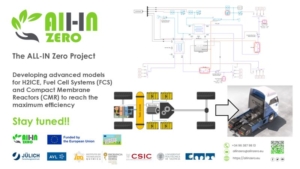🔥𝗛𝗼𝘁 𝘀𝘁𝗮𝗿𝘁 𝗳𝗼𝗿 𝘁𝗵𝗲 𝗺𝗼𝗱𝗲𝗹𝗶𝗻𝗴 𝗮𝗰𝘁𝗶𝘃𝗶𝘁𝗶𝗲𝘀 𝗼𝗳 𝘁𝗵𝗲 ALL-IN Zero 𝗣𝗿𝗼𝗷𝗲𝗰𝘁 🔥
It’s time to share the latest WP8 developments related to modeling in our project, supported by the European Commission through the HorizonEU Research and Innovation Funding Programme. This ambitious initiative is dedicated to advancing multi-fuel next-generation technologies for energy systems, focusing on the integration and optimization of power generation solutions with zero emissions.
Learn more about ALL-IN Zero here: https://allinzero.eu/
🚀 𝗞𝗲𝘆 𝗢𝗯𝗷𝗲𝗰𝘁𝗶𝘃𝗲𝘀 𝗼𝗳 𝗪𝗣𝟴 🚀
Our team has been making significant strides towards creating a robust modelling framework, targeting the integration of cutting-edge systems and exploring their synergies, with the following goals driving our efforts:
⚡Modelling the Core Systems: We are building detailed models for the CMR, H2ICE, and FuelCell systems (FCS), using high-fidelity experimental data.
⚖️ Energy Balance Optimization: We are working on understanding the specific requirements for integrating the power generation and the CMR systems, tailored to the energy balance of each individual subsystem.
💻 Virtual System Integration: We are performing the virtual integration of these systems with vehicle architecture, focusing on the selected target applications.
✅ 𝗖𝘂𝗿𝗿𝗲𝗻𝘁 𝘀𝘁𝗮𝘁𝘂𝘀 ✅
1️⃣ The preliminary models for the H2ICE and the FCS are under development and are already predicting H2 consumption in realistic driving conditions.
2️⃣ The CMR model for ammonia is under development and our latest simulations show how the CMR excess heat can be recovered to evaporate the ammonia to be used in the CMR for the onboard H2 production.
3️⃣ The initial layout for the integration of the power generation system and the CMR is under development after careful analysis of the reusable energy inflows and outflows of each system.
💡 𝗪𝗵𝗮𝘁’𝘀 𝗡𝗲𝘅𝘁? 💡
The next phase of our work will focus on refining these models, analyzing how to perform the virtual integration of the key subsystems, and moving towards a more sustainable, efficient energy solution. We are confident that the results of our work will lay the foundation for the seamless deployment of these technologies across various industries.
👏 𝗔 𝗕𝗶𝗴 𝗧𝗵𝗮𝗻𝗸 𝗬𝗼𝘂 𝘁𝗼 𝗢𝘂𝗿 𝗣𝗮𝗿𝘁𝗻𝗲𝗿𝘀 👏
We would like to express our gratitude to our partners for their outstanding contributions to this project.
Universitat Politècnica de València (UPV) – CMT–Clean Mobility & Thermofluids (UPV)
CSIC – Instituto de Tecnología Química (UPV-CSIC)
Forschungszentrum Jülich
AVL
AVL Ibérica
We also extend our gratitude to our project officer, Dr. Javier Sánchez López, from CINEA – European Climate, Infrastructure and Environment Executive Agency.
Stay tuned for more breakthroughs as we progress with determination and focus!
Innovation Sustainability #CleanEnergy Hydrogen FuelCell ZeroEmissions HorizonEU




